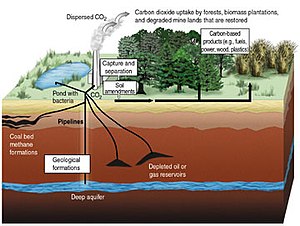Carbon sequestration - Simple English Wikipedia, the free encyclopedia

Illustration showing both terrestrial and geological sequestration of carbon dioxide
Carbon sequestration is the process of capturing carbon dioxide (CO2) gas in the atmosphere.[1] One method of sequestration is by capturing CO2 produced by power plants and factories before they release it into the atmosphere.[1] When the CO2 gas is in long-term storage, that means it has been sequestered.
Carbon sequestration aims to assist in elimination of human introduced carbon from Earth's atmosphere by disrupting the carbon cycle. It is also used to prevent future human caused climate change.[2]
Methods[change | change source]
There are two long-term ways to remove CO2 from the atmosphere:
- Terrestrial Sequestration- plants and trees store CO2 in their bodies and in their roots.[3]
- geologic sequestration- bury the CO2 thousands of feet underground.[4]
References[change | change source]
- ↑ 1.0 1.1 "What Is CO2 Sequestration?". University of North Dakota Energy & Environmental Research Center. Retrieved 15 December 2015.[permanent dead link]
- ↑ "Carbon Sequestration: Too Little, Too Late?". MIT Technology Review. Retrieved 15 December 2015.[permanent dead link]
- ↑ "Carbon Sequestration in Terrestrial Ecosystems". Oak Ridge National Laboratory (ORNL). Retrieved 15 December 2015.[permanent dead link]
- ↑ "Carbon Dioxide Capture and Sequestration". United States Environmental Agency (EPA). Retrieved 15 December 2015.
Wikimedia Commons has media related to Carbon sequestration.


 French
French Deutsch
Deutsch